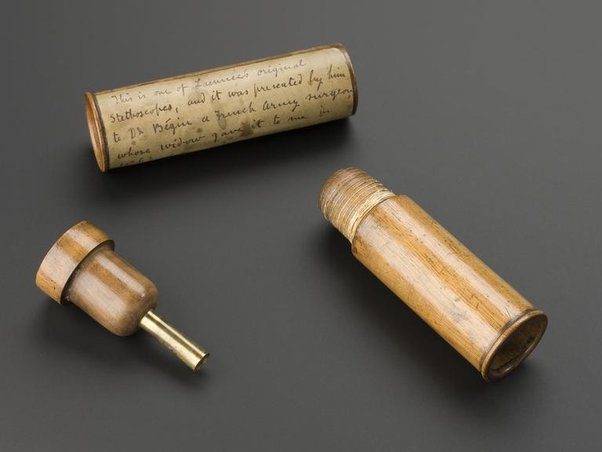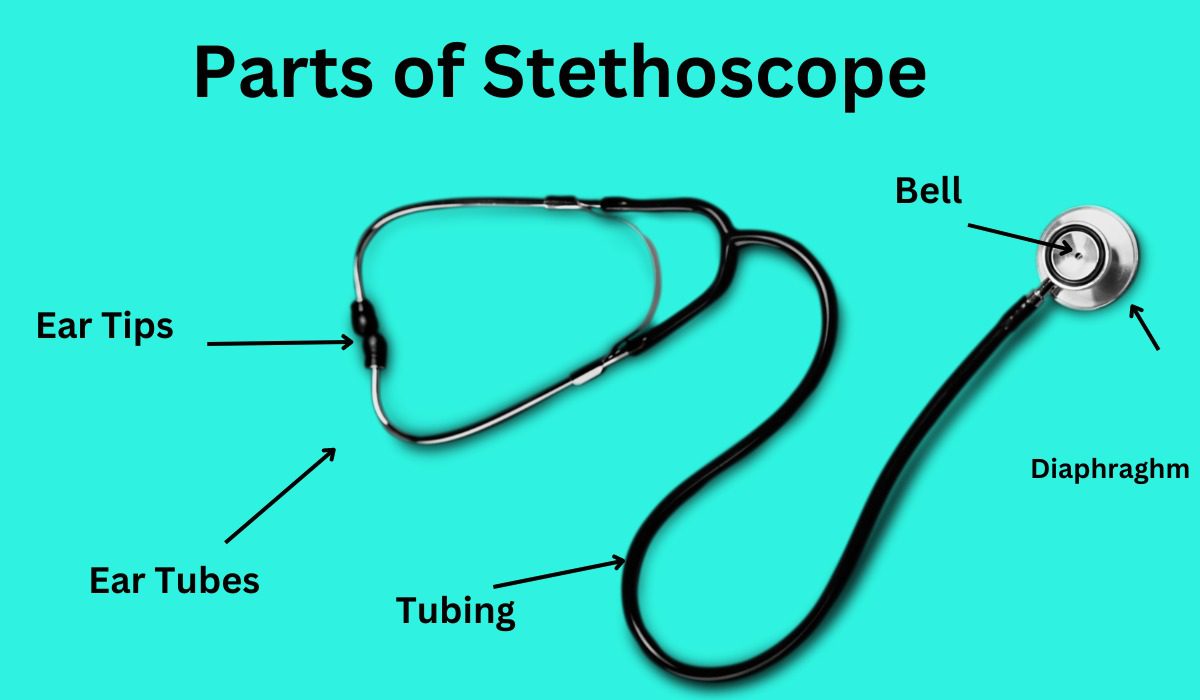A stethoscope is a diagnostic device medical professionals like doctors and nurses use to listen to sounds inside human and animal bodies. It consists of a y-shaped earpiece at one end and a chestpiece at the other with a diaphragm and bell.
A chest piece is placed on the patient’s body to listen to sounds like heart, lung, abdominal, and other internal body sounds.

Before the invention of the stethoscope, doctors used to put their ears on the patient to listen to the internal sounds of the body.
In some conditions, doctors feel uncomfortable when they put the ear on overweight patients due to external Noise Interference.
Evolution of the Stethoscope from paper to electronic
In 1816, a French physician named “Rene Laennec” came up with a solution and invented it for the first time.
He was in a situation where he had to check the chest sounds of a female patient and felt uncomfortable placing his ears directly. He folded a piece of paper and rolled it into a circle.
Then, He placed one end on the patient’s chest and put his ear on the other end of that folded piece of paper.
After that, he replaced that paper with a wooden tube, and the design and structure were refined later as time passed.

As time passed, the designs of stethoscopes also changed, and now we have different types of stethoscopes with unique features.
What are the Types of Stethoscopes
These are some types
1. Acoustic stethoscopes
These traditional stethoscopes used by medical professionals are portable, lightweight, and easy to carry. Use the traditional method by placing a chest piece on the patient’s body to listen to internal sound.
They are suitable for general physical diagnosis of the patient’s body due to listing a wide range of inner sounds,
We observe that Doctors, medical practitioners, nurses, EMTs(Emergency Medical Technicians), and surgeons commonly use these.
Further, we have two types that include
- Dual-Head
2. Single -Head
2. Electronic stethoscope
Electronic stethoscopes are more costly than traditional ones due to their advanced features and electronic components, such as batteries.
They have built-in amplifiers that amplify the sounds louder to make them audible.
These have advanced features such as recordings and playback to hear the sound later.
Unlike traditional stethoscopes, electronic stethoscopes use electrical signals produced due to the conversion of vibrations with a microphone inside a chest piece.
We can modify these signals according to our requirements.
3. Fatal stethoscope
They are also known as Doppler stethoscopes, specially designed to listen to the heartbeat of a fetus during pregnancy.
It uses ultrasound technology to detect and amplify the heart sounds.
3. Cardiology stethoscopes
We often use them to listen to cardiac sounds, such as murmurs and irregular rhythms, with enhanced acoustic capabilities.
4. Padriatic stethoscope
We primarily use these stethoscopes while diagnosing children to listen to their internal body sounds. Specially designed with a small size chest piece and diaphragm to fit children’s bodies best.
What are the Parts of Stethoscope:
Below are the different components of a stethoscope.

Earpiece
These are the part of the stethoscope that goes into the ears of a healthcare professional. Designed to provide comfort to the ear and minimize external noise while listening to the internal organs of the patient’s body.
Tubing
Tubes that connect the earpiece with the chestpiece are flexible and hollow inside and transmit sound between the earpiece and the chestpiece. Tubing allows professionals To listen to body sounds comfortably and without fear of breakage.
Chestpiece
The chestpiece connected at the opposite end of the earpiece and placed on the patient’s body to listen to internal sounds. It consists of two sides, including a diaphragm and a Bell.
Diaphragm
The diaphragm is a flat circular surface inside the stethoscope to listen to high-frequency sounds such as lungs, heart, and bowel sounds. It vibrates when placed on the patient’s body due to the internal sound of the body and sound transmitted through the tubing toward the ears.
Bell:
Most of stethoscopes have both bell and diaphragm parts in the chest piece. Used to detect and listen to low-frequency sounds in the body that might not listen by using the diaphragm. It detects sounds like certain heart murmurs, blood flow sounds in arteries, and bowel sounds with a low pitch.
Tuneable Diaphragm
A tunable diaphragm is commonly used in modern stethoscopes 3M Litman stethoscopes instead of a bell and diaphragm. It has advanced features that allow us to easily listen to low and high-frequency sounds by adjusting the pressure to be applied to the chest piece.
Y-shaped tubing
To keep the sound separate from each ear, Y-shaped tubes are used. One end of the tube connects to each earpiece, and the other couples with a single tube of chest piece through tubing connectors.
The critical question is, can we buy these parts in Pakistan? The answer is yes, and we can easily buy these parts in Pakistan at the best price of Rs 6,280/-.
Summary
In conclusion, the stethoscope is an essential diagnostic device commonly used by medical professionals for different needs and was first invented by Rene Laennec in 1816 while he was listening to the heartbeat of a female. Then, the design and structure refined with time, and now we have electronic stethoscopes used to listen to babies’ heart-beat even before they were born. There are different types of stethoscopes according to their need, and we can also buy their parts in Pakistan.

Write a comment
Your email address will not be published. All fields are required